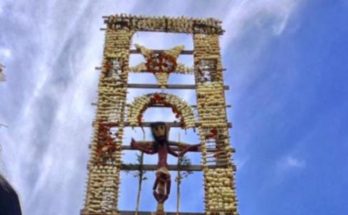Bridge Between Two Worlds
By José Arturo Morales Tirado
San Miguel Viejo is more than the first settlement of Spaniards (Diego de Nieto and Fray Juan de San Miguel, among others); and their indigenous allies of the main Otomi lords of Jilotepec (Nicolás de San Luis Montañés and Conín or Hernando de Tapia, plus others from Tlaxcala and Oaxaca). It’s more than the symbol of the first Spanish buildings in these lands and more than the first catholic symbols in these frontier lands between volcanic Mesoamerica and semi-desert Aridamerica. San Miguel Viejo is the living and built testimony to the natural and cultural evolution of the region over the last 25 centuries.
In the southernmost valley of its upper sub-basin at the beginning of Aridoamerica on the eastern shore of the Laja River, the first groups of the Chupícuaro Mesoamerican cultural tradition settled 2,500 years ago, at the end of the Mesoamerican Formative or Preclassic period. Their settlements were agricultural communities centered around corn, beans, pumpkin, chili, and many more agricultural species. They remained so for nearly 500 years, being part of the Mesoamerican civilization, one of the original six civilizations on the planet (the other five original civilizations, according to Miguel León Portilla, developed around the Yellow river in China, the Indus river in India, the Tigris-Euphrates rivers of Mesopotamia, the Nile river of Egypt, and the region of the central Andes in South America). Part of the cultural artifacts of the Chupícuaro during their time in San Miguel Viejo were their splendid white-on-black and red-on-tan ceramics. There are also the original glazed ceramics with significant local physiographic references to the altépetls (sacred hills) including the Cerro del Monito, the Cruz del Pueblo, the Cruz del Río, and even, around the coecillos (Mesoamerican temples) of the archaeological site of San Miguel Viejo.
In the Classic Mesoamerican Period, from about A.D. 500 to 1100, what is now the archaeological site of San Miguel Viejo was developed by indigenous people of the Otopame cultural group, and extending around the current Upper Laja river sub-basin. Based on the location of its at least nine coecillos, they occupied an area of about 150 hectares around the wetlands and agricultural land at the confluence of the Laja river and Cachinches arroyo (with its origin in the springs of the archaeological site of Agua Espinosa). The main pyramidal base, with sunken patios and platforms, is located about 800 meters to the west of the current Chapel of the Indians. The main coecillo is to the east of Mesa Grande del Malanquín and the Ojo de Agua spring on the famous Cerro de Montequehuma. To the west is the Toriles coecillos in the Mesa del Gato and to the north the coecillos de La Cieneguita and Xoté. And finally, there are the sunrise of the summer solstice at the Cruz del Pueblo, and sunrise of the winter solstice at the Cross of Forgiveness at the mouth of the Tinajitas canyon at the base of Palo Huérfano (or Los Picachos) volcano. For the San Miguel archaeologist Luis Felipe Nieto Gamiño, this was among the most extensive urban or mixed center in this Frontera Tierra Adentro (Inland Frontier), along with the archaeological sites of San Antón Ceballos and La Grulla.
San Miguel Viejo occupies a region in the cultural and geological border between volcanic Mesoamerica to the south and the semi-desert of Aridoamerica to the north. From the 13th to the 16th centuries, the region was inhabited by groups from the Chichimec cultural tradition, including groups of Copuces, Guamares, Guaxábanas, and others, until their encounter in the 1530s with the first Spaniards and their Otomi allies from Jilotepec. The historic foundations of modern structure began as an adobe, palm, and wood chapel in 1542, by Fray Juan de San Miguel, Diego de Tapia; plus the founders of San Juan del Río and Santiago de Querétaro: the future cacique of Tula, Nicolás de San Luis Montañés, and the principal of Jilotepec, Hernando de Tapia or Conín. After three years, this first chapel was destroyed, and in the 1570s, a presidio (military fort) was built for Spanish soldiers and gambusinos (gold and silver prospectors) with a masonry chapel for Indians that would evolve into the current one, built at the end of the 16th and beginning of the 17th century.
Due to the complex political, economic, cultural, social, and ecological dynamics of the Frontera de Tierra Adentro, the archaeological site and the colonial cultural assets in San Miguel Viejo have suffered from abandonment and interventions between 1542 and 1942 that have disfigured this wonder of our natural and cultural heritage that still retains so much of its exceptional value.
To be continued. arturomoralestirado@gmail.com




